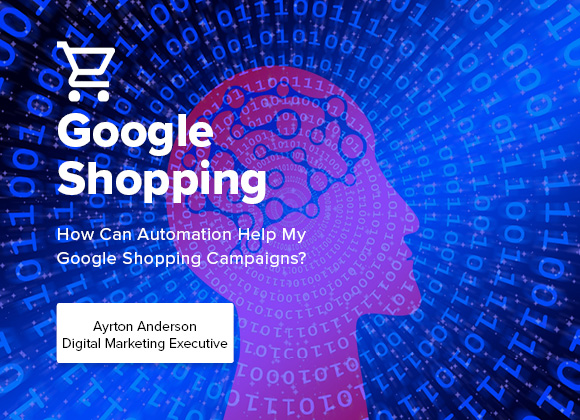Automation is a powerful ally when it comes to the management of your Google Shopping campaigns. The heavy lifting performed by account managers can be dealt with by a robot subject to your every command. Sounds perfect right?
And you would be correct. However, you need to find the right way of implementing your commands first, and this depends on what it is you would like to achieve, and your technical skillset.
How do you automate?
There are various ways to automate campaigns, some methods done within the Google Ads interface, and some not.
Google Ads Interface Rules
Google Ads Interface Scripts
Google Ads Interface Bid Strategies
Third-Party Software
Each comes with pros and cons and ease of usability, but what they all can do, is make your life a whole lot easier than it was beforehand.
The benefits?
Time is precious when it comes to account management. Checking for account issues, applying bid increases and the implementation of negative keywords are all laborious tasks that can take extortionate amounts of time. Time which could be spent elsewhere. Time which could be spent on other, potentially more important tasks. Luckily, the most substantial resource you can save with automation is in fact, time.
You will always be alert to what your account is doing, as email alerts can be sent to your inbox daily, giving you insights into account health and performance. Your entire account can be scoured, every scrap of data analysed and acted upon. So, let’s take a deeper look into the possibilities of automation and what ways they can be implemented.
Rules
The interface within Google Ads allows you to create some basic logic rules. You can find the rules tab here after clicking the spanner in the top right:
Once you are in the Rules tab, you can hit the big blue plus to begin creating new rules for your account.
Scripts
The Google Ads interface also allows you to create elaborate scripts for your account. The possibilities for these are endless, but understanding how to write scripts can be quite tricky. To find the Scripts tab, click the spanner in the top right, and then click Scripts.
Once in the scripts tab, click the big blue plus button to begin creating.
Staying Alert
As mentioned earlier, alerts can be one of the best ways to stay on top of your account, especially when your day may be filled with plenty of other tasks away from Google Ads. Enter the rules tab within the Google Ads interface, and you can begin setting up your alerts.
Choose the ‘Send email’ rule, and then begin setting your parameters. If you are managing a Google Ad Grant account, then you could add the condition that whenever you have a keyword of quality score of two or less, email me. Or perhaps you have thousands of Text Ads within your account. Choosing that when the ‘Policy approval status’ becomes ‘Disapproved’ and receiving an email from this will mean you’ll never miss one of those pesky disapprovals.
Scripts or Third Party software can go that bit further. Spikes or drops in impressions or search impression share can be the telltale signs that there is an issue. Be it with your feed, products or bids, the issues can be serious, but also incredibly hard to notice. By the time you do notice it, you could have missed out on potentially a lot of sales, so why not implement automation to notice this?
To spot this utilising Google Ads metrics, there are a couple of different parameters and logic checks that you can set up. A spike in impressions for your ‘everything’ product group could well mean that you’re having feed issues, such as a category has switched or broken, causing the filtering in your ad account to break and filter into the unassigned categories, or ‘everything’ categories. Equally, you could monitor for drops in search impression share. If Impression share drops, it could mean that the product is filtering elsewhere with a lower bid or the product is out of stock, which is also worth knowing. Monitor spikes or drops in metrics that you find important, and receive an email alert should these metrics change in undesirable ways.
Bid Management
Alerts are just the tip of the iceberg, however, as the possibilities stretch much further than just emails. The Google Rules allow for Campaign bid, Ad Group bid and Keyword bid increases and decreases, using parameters that you choose. You can’t edit product bids, however, to do this you will need to create a script or use third-party software that will allow you to change bids at the product group level.
Once you have the capabilities to make these changes, you can then start to think about what kind of bid adjustments you would like to make, by thinking about the exact thought process you have when routinely altering bids on your account. A low ROAS (return on ad spend) and a high-cost product over a certain amount of time is a pretty safe bet to decrease the bids on. This will reduce the overspend and increase the ROAS.
Think hard about the time frames you would look back on when examining these products, and think equally about how you would alter the bid on the particular product. Would this be a percentage decrease or a fixed amount decrease? Once you have the logic planned out in your head, mould this into your script or third-party software and begin saving that precious time from laborious, routine tasks.
Another take on bid adjustments could use CPA (cost per acquisition) rather than ROAS. If you can work out the CPA you require for your business to be profitable, then you can incorporate it into your automation logic. If your products have a high CPA, then you can also reduce the bids on these to bring the CPA back in line.
Google even has its own automated bid management built into the interface. These are known as ‘Bid Strategies’ and there are various ones to choose from. The automated strategies for Google Shopping are:
- Target ROAS
- ECPC (Enhanced Cost Per Click)
- Maximise Clicks
- Smart Bidding
These bidding strategies require you to input your ‘Target ROAS’ for example, and then the machine learning takes over the rest of the work, in an attempt to reach the target you set. Targets will then need to be tweaked over time, to make sure you are receiving the desired results, as although these are automated, they are not perfect. Bids are then set using Google’s Machine learning algorithms to hit the KPI.
You can find out more about all of Google’s own Automated strategies here.
Keyword Sculpting
Keyword Sculpting is a powerful way to boost your ROAS by sculpting traffic using negatives, so you can essentially bid differently on certain search terms. You can find a full guide on Keyword Sculpting in Henry’s blog here. Sculpting can also be automated, making the process much quicker and much more effective. Sculpting requires you to add multiple negatives to campaigns, and in certain circumstances, it can become extremely time-intensive if there are lots of metrics to study and plenty of negatives to add. That is where automation comes in.
Once you know how you want to keyword sculpt your campaigns, you can begin sorting out how exactly you want your negatives to be added. For example, if you would like your high bids to be on search terms that are known to convert, then you could create your automation to add negatives for those quality search terms and begin the filtering process.
You can even use automation to add poor search term negatives to your account. The usual process of trawling through search term reports finding poor search terms can be automated using simple logic. Negatives could be added for searches terms that cost over a particular amount, or for search terms that don’t gain a high enough CTR, depending on the nature of your account and the metrics you require. The more negatives added, the more you will see the speed of automation compared to manual implementation.
Some third-party software can even pick up attributes from your feed, and add them as negatives. For example, if you have multiple brands within your feed, then you can pull these attributes and add them as negatives, giving you the ability to bid a certain amount on generic terms, and more on branded search terms, which commonly have a higher intent to purchase.
Automation is almost essential when managing Google Ads accounts as there is now so much required to stay ahead of the game. From Keyword Sculpting to product level bid management, there is only so much you can do before your work impacts your many other tasks of equal importance. At eComOne, we use automation in its various forms to deliver our clients a results-driven strategy, pulling in from every aspect of automation. Find out how we can optimise your Shopping Campaigns using automation by getting in touch today!




